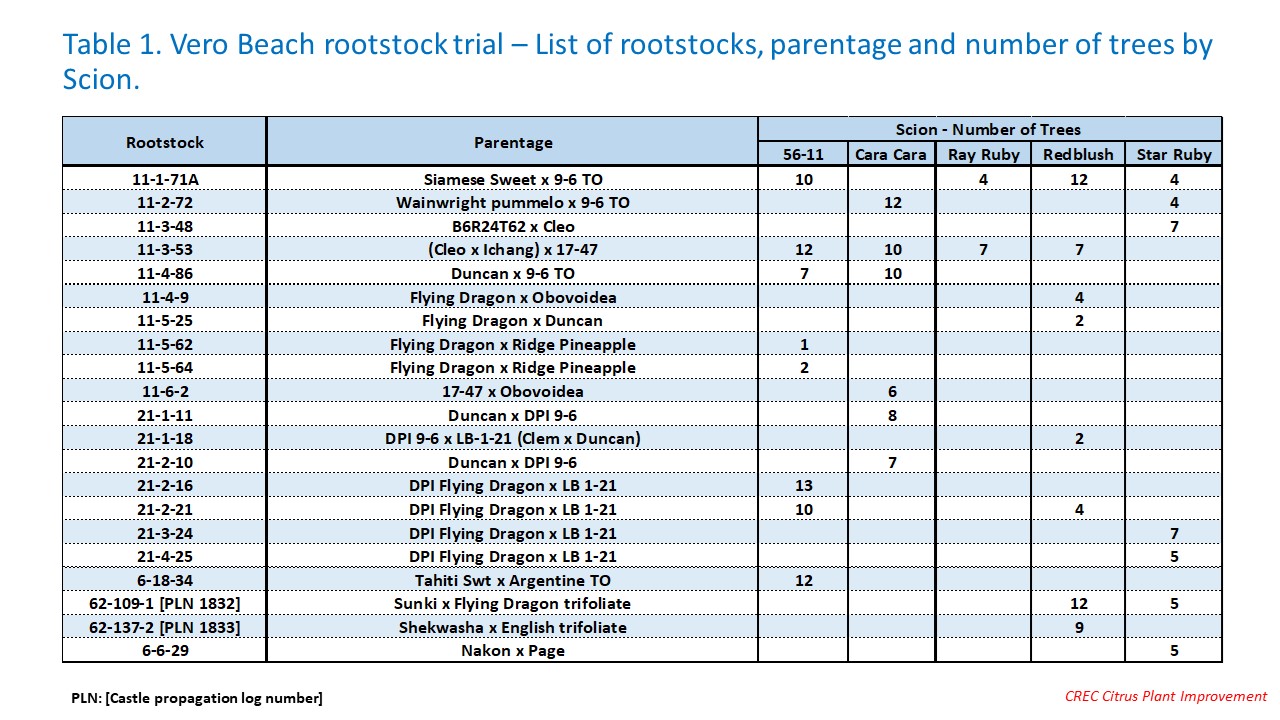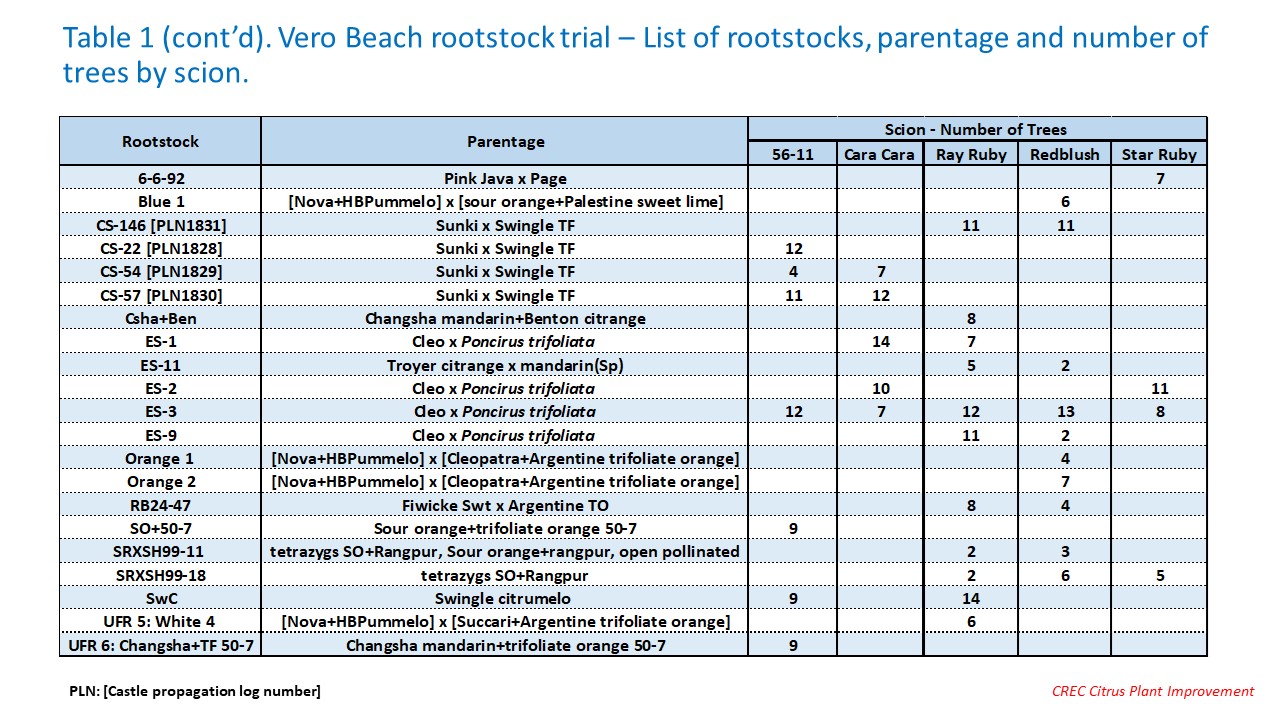Navel Orange and Grapefruit Rootstock Trial, Vero Beach
Dr. Bill Castle – Dr. Fred Gmitter – Dr. Jude Grosser
April 4, 2022 - Updated
June 30, 2021 - Updated
April 19, 2021 - Updated
November 16, 2020 – Updated
December 10, 2019 – Updated
July 26, 2019 - Posted
CREC Citrus Plant Improvement
Navel Orange and Grapefruit Rootstock Trial, Vero Beach - Description
This trial was planted in 2010 west of Vero Beach along Highway 60 and south on 146th Avenue. There are trees of Redblush, Ray Ruby and Star Ruby grapefruit and Cara Cara and standard navel orange clone 56-11 planted on 42 new hybrid rootstocks created in the UF/CREC plant improvement program or introduced from the USDA, the University of California, Riverside or Spain. There are also trees for comparison of Ray Ruby on Swingle citrumelo along with navel orange clone 56-11 on Swingle citrumelo. Tree numbers and rootstocks vary according to the scion.
Navel Orange and Grapefruit Rootstock Trial, Vero Beach - Summary
- Location: Vero Beach, Indian River County.
- Scion - Rootstocks:
- Navel orange: Cara Cara [11 rootstocks]; standard clone 56-11 [15 rootstocks].
- Grapefruit: Redblush [18 rootstocks], Ray Ruby [13 rootstocks], Star Ruby [11 rootstocks].
- Additional comparison trees: Ray Ruby/Swingle citrumelo; Navel 56-11/Swingle citrumelo.
- Date Planted: April 2010
- Design:
- Randomized complete-block with 2-4 replicates
- Plot size: mostly 3-5 trees
- Spacing: 7.5 x 22 ft. = 264 trees/acre.
- Data collected:
- 2015/16: Navel orange juice quality
- 2017/18: Grapefruit juice quality
- 2018/19: 2018/19: Grapefruit HLB rating and yield. Navel orange HLB rating, juice quality, yield and PS/acre.
- 2019/20: Grapefruit tree size, juice quality, yield and PS/acre. Navel orange tree size and yield.
- 2020/21: Grapefruit & Navel orange: HLB rating, tree size and yield.
- 2021/22: Grapefruit yield and juice quality. Navel orange juice quality, HLB rating and yield.
- 4-year cumulative yield for grapefruit and navel orange.
- Trial status: ACTIVE.


Navel orange and grapefruit rootstock trial, Vero Beach - Interpretive Summary [as of April 2021].
This trial was planted in April 2010 at 7.5 x 22 ft. and consisted of two navel orange and three grapefruit selections on various rootstocks with these caveats: [1] The overall trial was not balanced, i.e., the same rootstocks were not available for each scion. Even though there was good overlap, some rootstocks did not appear with one or more scions. As a result, a rootstock exhibiting good performance with, e.g., Ray Ruby grapefruit may not have been included in the Star Ruby part of the trial; and [2] HLB disease was present in the trial. Because greening-affected and unaffected fruit were not identified and separated at sampling, fruit samples likely consisted of unknown proportions of each type thereby affecting the value of the data.
Tree ht. At about 11 years old, the grapefruit selections were mostly 8-12 ft. tall [Figs. 27, 42] with some of the tallest ones being on C-146, ES-1, 62-137-2, Blue 1 and 62-109-1. The shortest trees were on ES-11. Among the navel orange trees, tree height ranged from 9-11 ft [Figs. 34, 43 ].
Yield. Among the individual years of yield of the grapefruit selections, top performing rootstocks included C-146, 4-1-71, Blue-1, 6-6-29, 62-137-2, UFR-5 and 11-2-72; among the 3 years of navel orange yield, ES-2, ES-1, C-54, C-57, 11-5-64 and 21-2-10.
Cumulative yield. For grapefruit and navel orange trees, those rootstocks that produced the higher annual yields were the same ones that were the most productive cumulatively.
Juice quality. Given the caveat stated in the preceding slide, it is likely that the data do not support any specific conclusions.
HLB. Among grapefruit trees that displayed fewer visial symptoms were those on ES-1, ES-2, ES-9, 62-109-1, C-146 and those apparently more affected were on ES-11. When yield and HLB ratings of one year were combined [Fig. 14], some of the higher ranked [higher yield, lower HLB response] rootstocks were Blue-1, 62-109-1, 6-6-29 and 11-2-72. Among the navel orange trees, those with fewer symptoms were on 11-5-62, 11-5-64, C-22, C-54 and ES-1 with the same observations being true when yield was combined with HLB ratings [Fig. 24].
Rootstocks. An examination of the data and standard deviations indicates that many outcomes were unlikely to be statistically different. However, a few rootstocks stood out for their consistent appearance among the trees with the best outcomes. The most obvious one was:
- 62-109-1 [Sunki mandarin x Flying Dragon trifoliate orange]
Others were 11-1-71, 72; Blue-1; 6-6-29; 21-2-10; 11-5-64.
Among the navel orange trees, the larger, more productive ones were those on ES-1 and ES-3, C-54, C-57 and S+50-7.

.jpg)